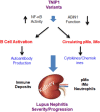TNIP1/ABIN1 and lupus nephritis: review
- PMID: 33122334
- PMCID: PMC7597513
- DOI: 10.1136/lupus-2020-000437
TNIP1/ABIN1 and lupus nephritis: review
Abstract
SLE is a complex autoimmune disease with genetic, epigenetic, immune-regulatory, environmental and hormonal factors. Kidney inflammation and injury, termed lupus nephritis (LN), occurs in over half of patients with SLE and is a leading cause of disability and death. There is a high degree of short-term and long-term side effects associated with current LN therapies and they are not effective for many patients. Thus, novel therapies with reduced toxicity and improved efficacy are drastically needed. Many of the known LN susceptibility genes have functions that mediate inflammation via cytokine/chemokine production and activation of myeloid and B cells. Understanding the cellular and molecular mechanisms mediated by these variant gene products provides valuable insight for the development of improved and personalised diagnostics and therapeutics. This review describes variants in the TNIP1 (tumour necrosis factor α-induced protein 3-interacting protein 1) gene associated with risks for SLE and LN and potential roles for loss of function of its protein product ABIN1 in the activation of myeloid and B-cell-mediated injury in LN.
Keywords: genetic; inflammation; lupus erythematosus; lupus nephritis; polymorphism; systemic.
© Author(s) (or their employer(s)) 2020. Re-use permitted under CC BY-NC. No commercial re-use. See rights and permissions. Published by BMJ.
Conflict of interest statement
Competing interests: DJC reports personal fees from Retrophin, GSK and Aurinia.
Figures



References
Publication types
MeSH terms
Substances
Grants and funding
LinkOut - more resources
Full Text Sources
Research Materials
